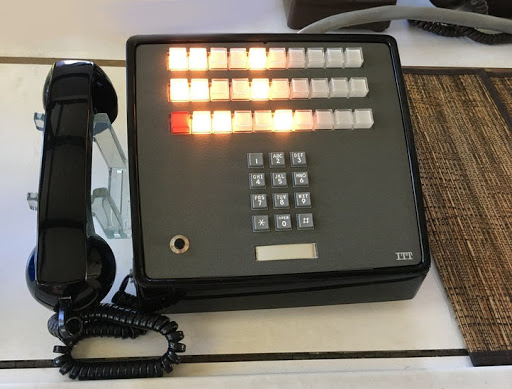Conferencing Calls on Telos Hybrid Systems
Scope
Methods for combining calls for teleconference on a Telos Hybrid system. (with pros and cons)
Description
Since the beginning of the Telos legacy, conferencing phone calls for air interviews has been a desired function of the system in many areas. In this article, we will discuss the different methods used to create conference calls and the consequences that are involved.
Line Mash Conference
Line or button mash conferencing is still the most popular way to create a conference on a Telos system. But what exactly does button or line mashing mean anyway?
Let's take a trip down memory lane. Way back when the original Telos 10 system was in production, the mainstay of telephony was the 1A2 key system. This used electro-mechanical relays with multi-pair cables and telephones with latching line buttons.

To seize a phone line, the user lifts the receiver and selects a line from the line bank. The button latches down, the lamp is illuminated, and dial tone is presented. When the receiver is placed back on the cradle, the line button returns to its out position and the line is released.
A conference is established by lifting the receiver and mashing two or more line buttons down at the same time. This would cause all the buttons pushed to latch together, bridging the lines for a conference. Placing the receiver back on the cradle releases the lines.
The Telos 10 merely looked like another key phone to the rest of the system but obviously had more going on than your average key phone. Logic circuits were used in the handling of phone lines instead of latching buttons. Since the line buttons on the Telos switch console were momentary instead of latching, we devised a workflow for line mash conferencing that continues to this day:
- 1st press activates a line
- 2nd press locks the line
- 3rd press unlocks the line
- etc.
Once a line is locked, another can be selected, locked, and so on. This wasn't a traditional button mash in the literal sense of the phrase, but it still looked like one to the key systems of the time.
While key systems are a thing of the past, this same line locking method is used on a modern Telos hybrid system to create a conference with multiple callers on a single hybrid. We still refer to this as a "button mash" conference.
Advantages
- Multiple callers can be placed on a single console fader.
- It requires no additional hardware
Disadvantages
- The noise on each call adds up, increasing the noise floor for each call added to the conference.
- The AGC and equalization algorithms in the hybrid will process the sum of all callers (including the noise)
- The impedance of the line interface changes each time a new line is added to the hybrid (POTS only)
- Modern POTS simulators may see a line mash as a feedback loop and may terminate calls unexpectedly (only applies to legacy Telos hybrid systems and should not be an issue with the Hx / iQ POTS systems)
Sometimes the advantages outweigh the disadvantages until the disadvantages start to become a problem. The disadvantages listed here mean the more lines are added to the hybrid, the worse the caller audio will be. Also if the impedance changes too drastically, the callers in the conference may lose the ability to hear each other. No adjustments can be made at this point, except to employ a second hybrid as explained in the next section.
Today in SIP telephony, the Telos VX system can still perform a traditional line mash conference using the workflow explained above, even though analog lines aren't being bridged together anymore.
Dual Hybrid Conference
Historically, the tried and true way for a higher quality conference is to have more than one hybrid. Using the alternate set of line keys on the switch console / controller, the user can control the second hybrid along with the first one. One application is for expert callers to be interviewed on one hybrid while regular callers / listeners are taken on the other for Q&A.
Advantages
- The producer has more control over the caller audio and the audio fed back to the caller
- There's a less likely chance of accidentally dropping the wrong caller
- The caller audio on each hybrid is processed separately.
- Impedance ranges on the phone lines can be better maintained (POTS only)
Disadvantages
- A second hybrid is needed
- It consumes a second fader at the console
- Separate mix minuses need to be created
Since there are clear advantages to dual hybrid conferences, modern Telos phone systems have eliminated the disadvantages by including two or more hybrids built-in with the ability to mix audio to a single fader.
In situations where line mash conferencing creates issues, it's always recommended that a second hybrid be used for conferencing.
You want more?
For further reading about conferencing calls on your Telos System, refer to the appropriate product manual for the system you have. If you would like a longer trip down memory lane, check out the original Telos 10 manual written by our founder, Steve Church here:
Let us know how we can help
If you have further questions on this topic or have ideas about improving this document, please contact us.
